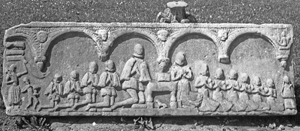Robert Cusack (judge) facts for kids
Robert Cusack (born around 1516, died 1570) was an important Irish judge in the 1500s. He served as a Baron of the Court of Exchequer (Ireland), which was a high court. He was considered for an even bigger job, Chief Baron of the Irish Exchequer, but someone else got the role. Sadly, his career ended when he died quite young.
Robert came from a well-known family in the Pale, an area in Ireland controlled by the English. Even though there were questions about whether his parents were legally married, this did not stop him from having a successful career.
Contents
Robert Cusack's Family Background
Robert was born in Cussington (now Cushinstown), County Meath. He was the oldest son of Sir Thomas Cusack, who later became the Lord Chancellor of Ireland. His mother was Joan Hussey, who was also his father's cousin.
His parents' marriage was not happy. In 1537, it was ended because they were too closely related. Robert's father always said that his marriage to Joan was not valid. He called his second wife, Maud Darcy, his first "lawful" wife. However, Thomas did accept Robert and his other children with Joan as his own. He also seemed to treat them well.
In the 1550s, Robert lived at Lismullen Abbey. His father had gained this property when monasteries were closed down. Robert's sister was actually the last leader of Lismullen Abbey. Later, Robert lived at the family's older home in Cussington. A man named John Cusack, who owned Cussington and died in 1629, was probably Robert's son.
Robert Cusack's Career as a Judge
Robert started his law studies at the Inner Temple in London around 1552. This was a place where lawyers trained. He later became a Master of the Revels there, helping to organize entertainment. After finishing his studies, he became a lawyer and returned to Ireland to work.
In 1561, he became the second Baron of the Irish Exchequer. This was a judge's position, and he earned £30 each year. In 1566, he was chosen to be one of three members of the Council for the Government of Munster. This council helped to rule that part of Ireland. However, he was accused of being too kind to Gerald FitzGerald, 15th Earl of Desmond, a powerful Irish leader.
Robert also served on several Royal Commissions in the 1560s. These were special groups set up by the King or Queen to do specific tasks. Robert's tasks included surveying lands, settling arguments over who owned land, and talking with the O'Reilly clan. In 1567, he and other senior judges were given the right to rent parts of King's Inn, a place for lawyers. He was also given control over the care of young people who had lost their parents, including his niece Mary Wise.
Robert's Bid for Chief Baron
Robert was a strong Protestant. At that time, many Irish judges, including his own father, followed the Church of Ireland in public but practiced the Roman Catholic faith in private. Robert's supporters even called him "the only Protestant on the Bench," though this was likely an exaggeration.
Because of his strong support for the Reformation (a big change in the Christian church), Robert was suggested for the job of Chief Baron in 1570. This was after the previous Chief Baron, James Bathe, died. Robert wrote to William Cecil, 1st Baron Burghley, a trusted advisor to Queen Elizabeth I. He argued that he deserved the job because of his long and loyal service to the Queen.
He had many powerful people supporting him. These included Adam Loftus, the Archbishop of Dublin, Hugh Brady, the Bishop of Meath, and the Queen's cousin, Thomas Butler, 10th Earl of Ormonde. However, Queen Elizabeth chose Sir Lucas Dillon instead. Dillon was James Bathe's son-in-law, and he was known to lean towards the Roman Catholic faith.
The Queen did say that if Dillon had not had what she saw as a stronger claim, she would have given the job to Robert. She said, "we hear very good report of him." She wanted him to know not to be "discouraged." Robert would almost certainly have received another important job if he had not died in the summer of 1570. His father passed away a few months after him.
Robert Cusack's Marriages and Children
Some records say that Robert married Margaret Kiltane when they were both very young, but this marriage was later ended. He then married Katherine, who was the daughter of Sir Christopher Nugent. Her mother was Marian St Lawrence.
Robert and Katherine had seven children:
- John (died 1629) who lived in Cussington.
- Fr Christopher Cusack (died 1624), who became a Roman Catholic priest. He started the Irish College, Douai, a school for Irish priests in France.
- Anne, who married Richard Luttrell.
- Margaret, who married John Plunkett.
- Genet.
- Catherine, who married Thomas Delafield.
- Elizabeth, who married Gerald Fleming. She was the mother of Patrick Fleming (1599-1631), who was also a well-known Roman Catholic priest.
After Robert died, his wife Katherine married again to Peter Barnewall, 6th Baron Trimlestown. They had more children together. Francis Lavalin Nugent, a Catholic priest who started the Capuchin Order in Ireland, was Katherine's nephew.
Robert's sister, Catherine Cusack, married Sir Henry Colley. She was an ancestor of the 1st Duke of Wellington, a very famous military leader. His family later changed their name from Colley to Wellesley.


